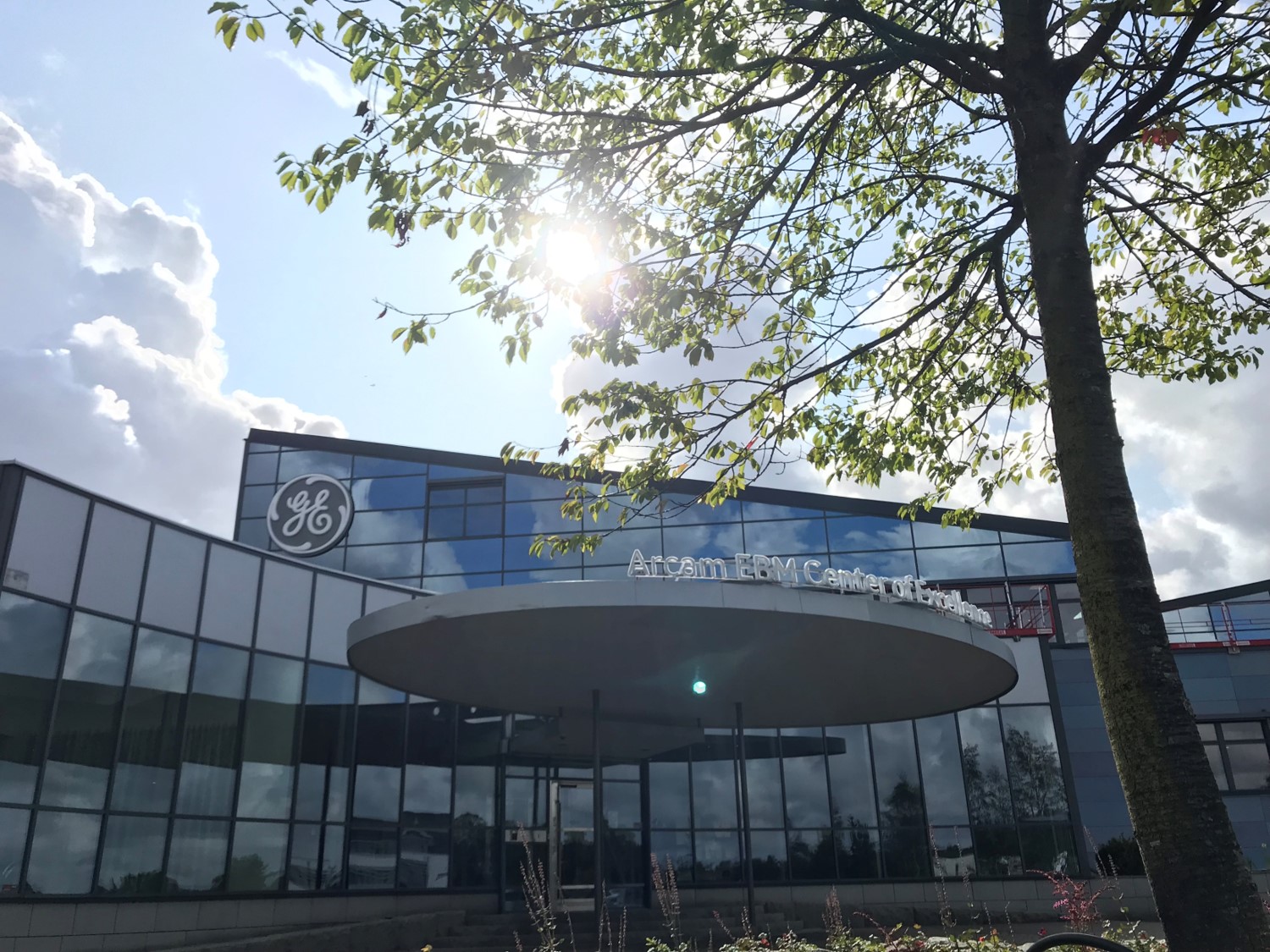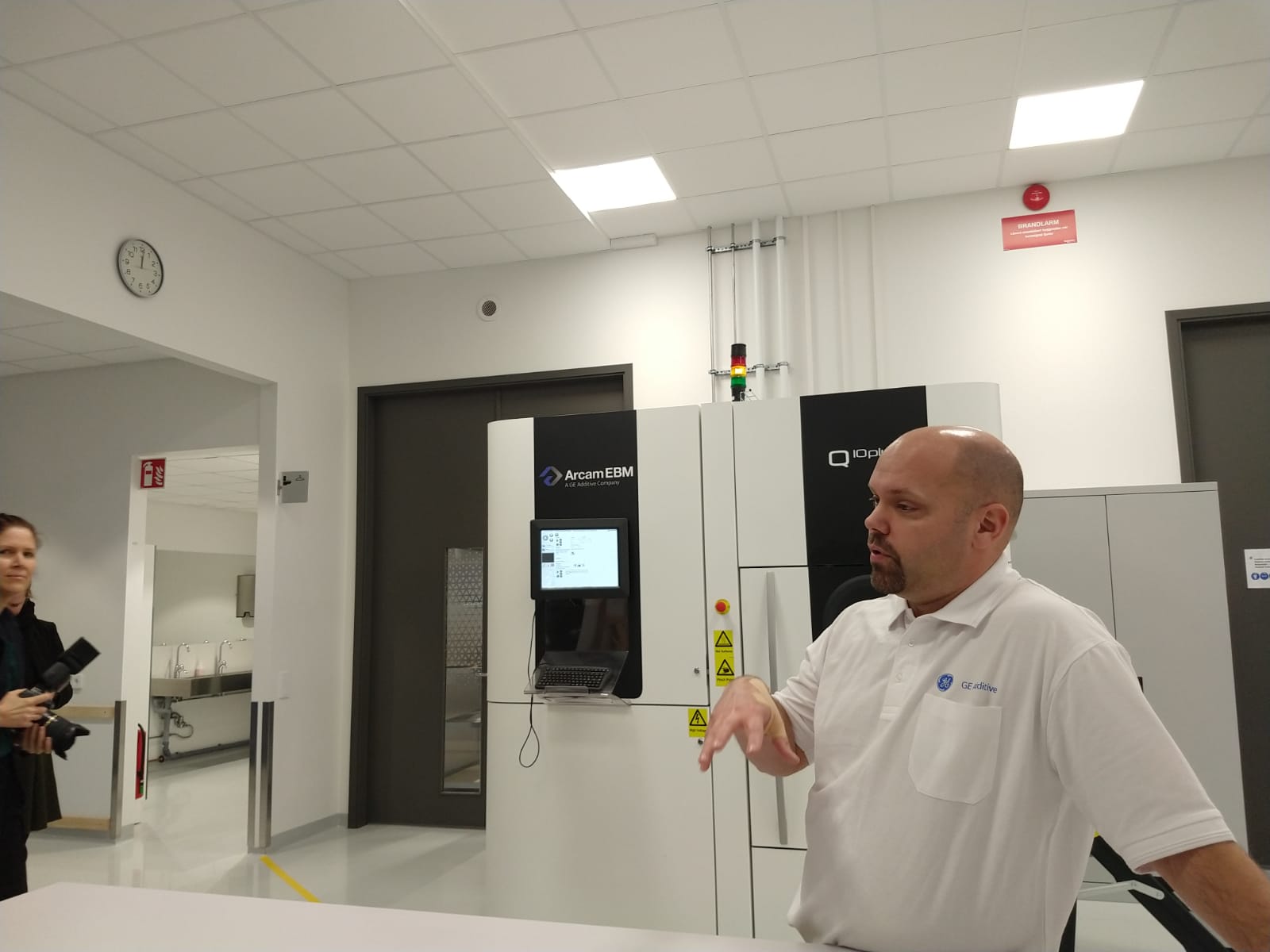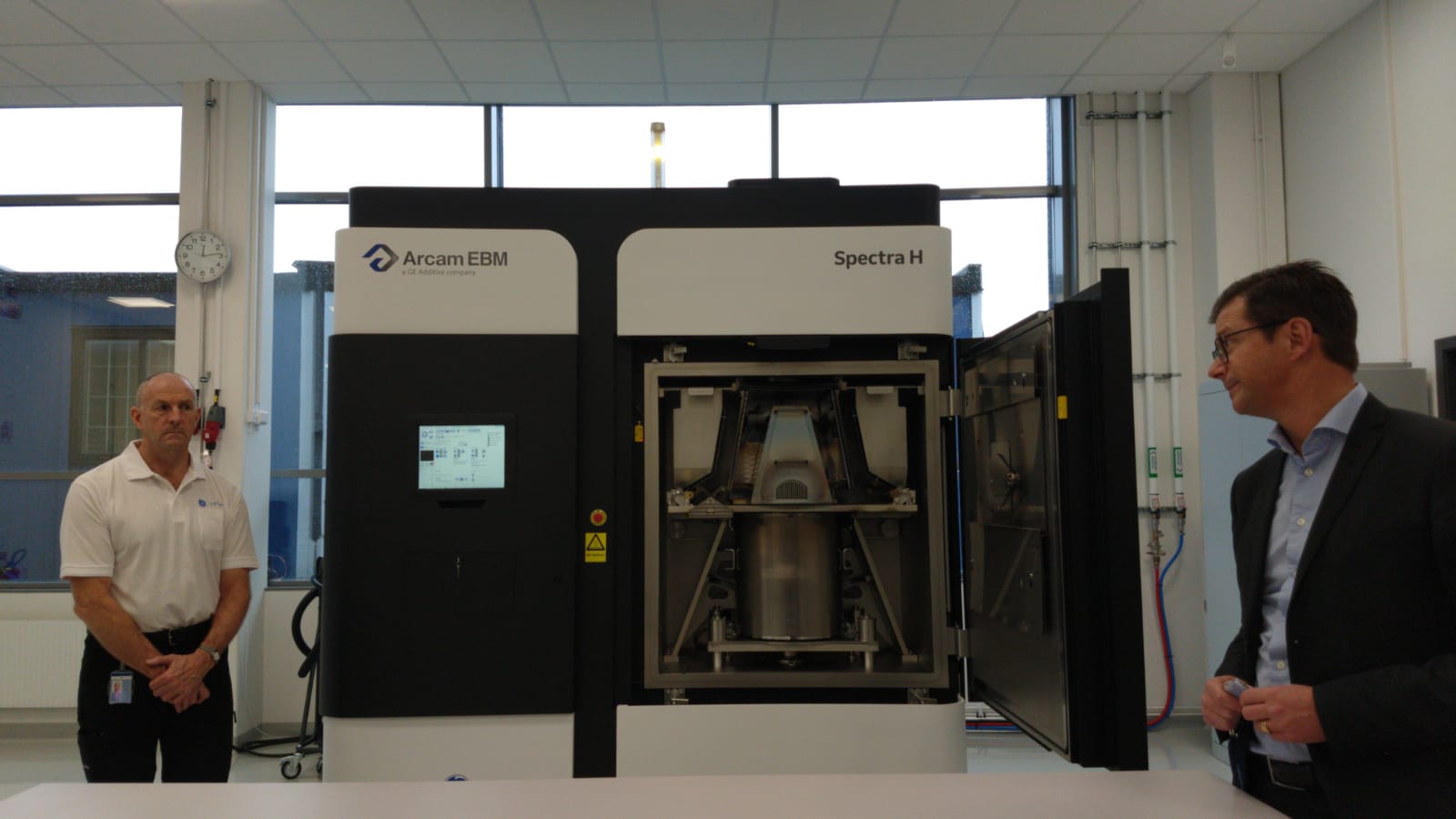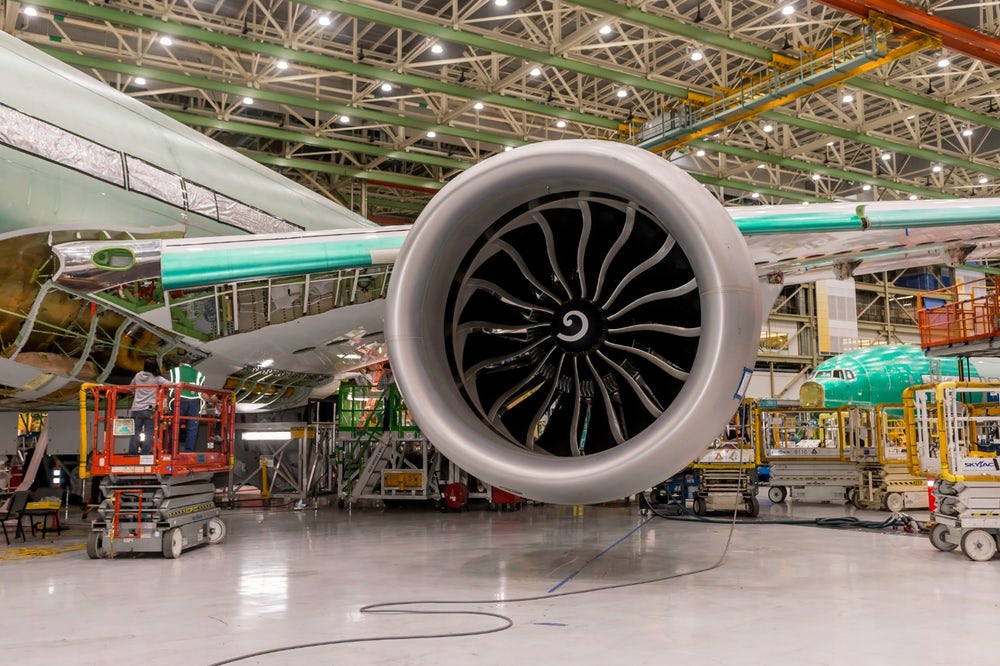GE Additive invited 3D Printing Industry for a tour of the Arcam Electron Beam Melting (EBM) Center of Excellence, a new 15,000 square meter additive manufacturing facility in Gothenburg Sweden opened in August 2019.
Situated at the Mölnlycke Business Park, the new facility triples the floor space of Arcam’s previous site in Mölndal. It has capacity for up to 500 employees and is fully equipped with production, R&D, training facilities and support functions. Costing €18 million, the facility was opened by GE Additive with a significant focus on putting lean manufacturing at the heart of its operations, to increase production capacity.
As GE Additive opened the doors of the Arcam EBM CoE for a tour of the site, I got the chance to speak to Jason Oliver, CEO of GE Additive about the new facility, the company’s acquisition of Arcam, and the future of the additive manufacturing industry.

The facility highlights GE’s commitment to developing Arcam’s EBM technology. Explaining the importance of the new space, Oliver states that the Arcam EBM CoE can help to establish a nurturing environment for employees, and a positive impression on customers:
“Brilliant teams need to be given an environment so that they can engage, develop, think, be creative; it matters a lot.”
“It also matters for customers who want to come in, they want to see that you’re committed, they want to have an environment where they can also collaborate. If you look at the structure and openness of this place, it has dedicated areas for collaborating and training customers. You know all those are important, and people need to feel comfortable working here whether it’s our employees, whether it’s our customers or even our suppliers.”
The Arcam EBM Centre of Excellence
Founded in 1997, Arcam’s EBM additive manufacturing technology was developed in collaboration with Chalmers University of Technology, Gothenburg. Its first machine, the EBM S12, was launched in 2002. Since then, the company has gone through several further system variations, including the recent introduction of the Arcam EBM Spectra L at Formnext 2019.

GE completed its acquisition of Arcam in January 2018, and began the relocation from Arcam’s previous facility in Mölndal to the new site in Gothenburg in April that year. Taking over the facility from a 2D printing company – the previous tenant – GE Additive performed a complete rebuild. The first office-based team members relocated in June 2019 and the production and logistics followed over in early December 2019.
The opening of the new facility has enabled GE Additive to focus on lean manufacturing principles, which includes cutting waste from its operations. “Embracing lean principles means that you have an environment where things are where they’re supposed to be, enabling a flow of production. So this is a great opportunity to step in to an area and apply lean across the board,” comments Oliver. The expanded manufacturing footprint of the facility will also support GE Additive in meeting customer demand for Arcam’s EBM technology, which the company attributes to an increase in users making the shift from prototyping to additive manufacturing for serial production.
Additionally, Oliver also highlights the importance of the facility as a statement of commitment from GE to additive manufacturing: “I think the reason that you can sit in a facility like this today is proof that GE’s pretty darn committed to our business. If you go sit in our Lichtenfels facility GE has already invested €150 million alone just in the last couple years. So, the investments are numerous, we’re talking big money in most cases; GE’s fully in.”

Discussing GE’s acquisition of Arcam, Oliver explains that GE Additive has gained valuable insight into EBM technology and adopted some of Arcam’s best practices throughout the firm: “I think there’s been the benefit for GE additive in having Arcam and it’s unique approach, its located approach, its location here in Sweden. GE has learned about the technology and applied those best practices in other parts of GE additive.”
Significantly, the acquisition has been a mutually beneficial process as well, according to Oliver: “I think Arcam has definitely benefited from GE’s focus on quality process, supplier quality, and the ability to get the word out in the marketplace about from a communication standpoint, from a sales standpoint; we can scale businesses, and we’re used to doing that.”
Consolidation in the metal AM market
From outside the 3D printing industry, GE can be considered an important banner waver for the potential of metal additive manufacturing. The purchase of both Arcam and German metal 3D printing manufacturer Concept Laser from GE marked the company’s transition from a user of additive manufacturing technology to a provider. Such consolidation in the metal additive manufacturing market has been a trend in recent times and has been highlighted as a key development to watch out for in the next decade. The likes of DMG MORI, EOS, Siemens and Xerox have all extended their foothold within the market with the purchase of metal 3D printing enterprises.

Oliver states that consolidation is only natural for the additive market as it continues to grow: “there’s a general evolution for new technology and new industries and so additive is going to go through similar kinds of growth and then consolidation, and then further growth and expansion.” This is particularly true for hardware suppliers, explains Oliver, as smaller companies aren’t able to compete in the market without the right investment.
“I think there is definitely a shake up coming. GE, along with a couple of others, are proving that if you can’t scale and if you don’t have the investment available to grow and build world class facilities and therefore provide quality products to the customers, you’re going to struggle. So those smaller companies can’t make that next step.”
What’s next for GE Additive and the 3D printing industry?
Recently, GE Additive entered into a five-year cooperative research and development agreement (CRADA) with Oak Ridge National Laboratory (ORNL). To drive the industrialization of additive manufacturing, the partners are focusing their research on process simulation methodologies and in-situ monitoring and quality control. Oliver believes that software, automation, and artificial intelligence will have a big impact in the next decade of additive manufacturing: “One of the reasons it has taken so long [for users] to really adopt additive manufacturing and make it work is that there’s a lot of trial and error, in order to optimize all the different inputs and processes. Software and machine learning can fix a lot of that, we can do a lot of simulation work between the actual design and print itself. So by modeling and using machine learning, we will be able to help customers get a quality part a lot faster.”

One of the key industries highlighted by Oliver where additive manufacturing has really gained a significant foothold is aerospace. GE Aviation’s GE9X engine, the most powerful commercial aircraft jet engine in the world, features over 300 3D printed parts. The dominance of 3D printing in aerospace means that engineers are no longer thinking what can be 3D printed; it is already a part of the process: “Additive is key for GE Aviation and they’re definitely the furthest along than anybody in any industry in terms of understanding what the capabilities of additive are. It’s not really going to be a question of ‘we’re designing an engine with more additive manufacturing’. Now the engineers think additively, it’s more about ‘’Oh you know what, additive isn’t the right answer’, where everywhere else additive is the answer.”
With aerospace, and to a lesser extent medical, being at the forefront of additive manufacturing, Oliver predicts the next industry to look out for is automotive. Although already prominent in high-performance applications, more work needs to be done for the general automotive market to adopt additive manufacturing,
“The big enchilada that everyone’s excited about is automotive. Additive is playing in the top end right now using laser systems or even Arcam machines for Formula One improvements, where they’re willing to pay anything to get a fraction more efficiency out of the engine. But for broader automotive yet there’s not a great answer there.”
A significant part of GE Additive’s upcoming plans lies in bridging that gap. The company is preparing a new binder jet solution, which it thinks will meet the manufacturing demands of the automotive industry as a whole: “They need speed they need high volume, and that’s where we think our new binder jet solution will play big in automotive. We’ve already got a couple of good partners on that side who are working on the technology with us so we’re pretty excited about that.”
The nominations for the 2020 3D Printing Industry Awards are now open. Who do you think should make the shortlists for this year’s show? Have your say now.
Subscribe to the 3D Printing Industry newsletter for the latest news in additive manufacturing. You can also stay connected by following us on Twitter and liking us on Facebook.
Looking for a career in additive manufacturing? Visit 3D Printing Jobs for a selection of roles in the industry.
Featured image shows the new GE Additive Arcam EBM Center of Excellence. Photo via GE Additive


